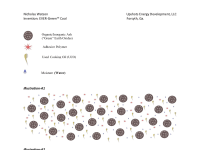According to the World Coal Association (https://www.worldcoal.org/), the energy and cost benefits associated with coal combustion plays a vital role in the robustness of the electric-power generation, steel, and cement industries. Coal combustion accounts for 37% of global electricity generation. EVER-Green™ Coal is an engineered solid fuel alternative to traditional coal, providing a cleaner burn with high energy values and fewer emissions of CO2 (Carbon Dioxide), SO2 (Sulfur Dioxides) and NOx (Nitric Oxides) gases and eliminates other toxins (i.e. aluminum, beryllium, arsenic, mercury, lead, etc.…) that commonly cause groundwater contamination during the storage of combustible coal residue (CCR) located within coal ash ponds. EVER-Green™ Coal combines a unique blend of a “nontoxic” organic and/or inorganic ash; used cooking oils, and patent pending polymer adhesion to form a pelletized carbon-based fuel that does not produce ash residue and allows for 100% beneficial reuse of coal ash. EVER-Green™ Coal comply with EPA’s (Environmental Protection Agency) beneficial reuse definition (Federal, 40 CFR Part 257, Subpart D) for encapsulated coal ash and elimination of coal ash ponds, providing societal and economic benefits. EPA concludes that the new dry handling standards for coal ash storage will yield an estimated benefit of $463 million dollars per year to Americans across the country in the form of reduced cancer risk, neurological risk, and drinking water risks.
Description of the EVER-Green Process on a Molecular Scale:
1. “Green” (nontoxic) ash particles size is reduced to less than 1000 microns to increase surface area and improve the availability of carbon at the surface needed for adhesion.
2. A mixture of Green ash, UCO, Water and Polymers are combined and mixed to form an adhesive. Sufficient amount of mixing time and rates are needed to achieve the appropriate quantities of adhesion and aggregation. (See Illustration-A1.)
3. As the mixture is blended, the long hydrocarbon tails on UCO adhere to carbon at the surface of the ash to form small clusters of Green ash particles coated by UCO to form a negatively-charged, ash-UCO cluster. The moisture derived from the surface of the ash particles and the UCO surrounds the ash-UCO clusters by an electrostatic attraction of the negative charge of UCO head and the polar bonds in water to further induce mixing. (See Illustration-A2.)
4. At a continuous batch-blending rate, Polymers bind to the outer surface of the ash-UCO clusters to form larger, Polymer-coated particles by an application of a steady shear force and low mixing rate to form a pellet. (See Illustration-A3.)
Like this entry?
-
About the Entrant
- Name:Nicholas Watson
- Type of entry:individual
- Software used for this entry:Not applicable
- Patent status:pending





